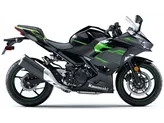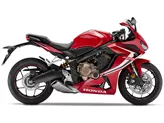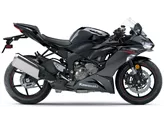Kawasaki Ninja 650 2017 vs. Kawasaki Ninja 400 2018

Kawasaki Ninja 650 2017

Kawasaki Ninja 400 2018
Přehled - Kawasaki Ninja 650 2017 vs Kawasaki Ninja 400 2018
The Kawasaki Ninja 650 2017 and the Kawasaki Ninja 400 2018 are both supersport motorcycles from Kawasaki, but they have some notable differences in their technical specifications and strengths.
Starting with the engine and drive train, the Ninja 650 2017 has a larger displacement of 649cc compared to the Ninja 400 2018 with a displacement of 399cc. This results in the Ninja 650 having more power, with an engine power of 68.2 HP compared to the Ninja 400's 45 HP. The Ninja 650 also has higher torque at 65.7 Nm compared to the Ninja 400's 38 Nm. However, the Ninja 400 has a higher compression ratio of 11.5 compared to the Ninja 650's 10.8, which can contribute to better performance.
In terms of suspension, both motorcycles have telescopic forks in the front and swing arm suspension with a monoshock at the rear. The Ninja 650 has a front suspension diameter of 41mm, while the Ninja 400 has the same diameter. Both motorcycles have preload adjustment for the rear suspension.

Kawasaki Ninja 650 2017
When it comes to the chassis, both the Ninja 650 and the Ninja 400 have a steel frame with a tubular design. The Ninja 650 has a slightly steeper rake angle of 65.5 degrees compared to the Ninja 400's 63 degrees. The trail, which affects the stability and handling of the motorcycle, is also different, with the Ninja 650 having a trail of 100mm and the Ninja 400 having a trail of 93mm.
In terms of brakes, the Ninja 650 has double disk brakes in the front with a diameter of 300mm, while the Ninja 400 has a single disk brake with a larger diameter of 310mm. Both motorcycles feature petal technology for improved braking performance. Additionally, both motorcycles come with ABS as an advanced rider assistance system.
Looking at the dimensions and weights, the Ninja 650 has a wider front tire width of 120mm compared to the Ninja 400's 110mm. Both motorcycles have the same front and rear tire diameter of 17 inches. The Ninja 650 has a longer wheelbase of 1410mm compared to the Ninja 400's 1370mm. The seat height of the Ninja 650 is slightly higher at 790mm compared to the Ninja 400's 785mm. The Ninja 650 also has a higher kerb weight of 193kg compared to the Ninja 400's 168kg. Both motorcycles have a fuel tank capacity of 14 liters.

Kawasaki Ninja 400 2018
In terms of strengths, the Ninja 650 2017 is known for its transparent chassis for sport, playful and good-natured handling, excellent brakes, sharp looks reminiscent of the ZX-10R, and a resilient engine. On the other hand, the Ninja 400 2018 is praised for its chassis suitable for sporty use, low weight for effortless handling, engine with smooth response, relaxed and confidence-enhancing seating position, and LED headlights.
As for weaknesses, the Ninja 650 2017 is criticized for having little sound from the stock exhaust and slight vibrations from the engine. The Ninja 400 2018, on the other hand, has non-adjustable brake and clutch levers and can produce enormously loud wind noise with the original windshield for riders over 180cm tall.
In conclusion, while the Ninja 650 2017 offers more power and torque, the Ninja 400 2018 excels in its lightweight and nimble handling. Both motorcycles have their own strengths and weaknesses, catering to different riders' preferences and riding styles.
Technické údaje Kawasaki Ninja 650 2017 ve srovnání s Kawasaki Ninja 400 2018
Výhody a nevýhody ve srovnání
Výhody a nevýhody ve srovnání
Kawasaki Ninja 650 2017

Ninja 650 pevně razítkuje svého předchůdce (Er-6f). Motor dobře zvládl překážku Euro 4 a podává velmi použitelný výkon 68 k, podvozek je na tuto třídu prostě skvělý a snížení hmotnosti o 18(!) kg oproti ER-6f opravňuje k uctivému pokývání hlavou.
Kawasaki Ninja 400 2018

Celkově lze model Ninja 400 označit za dokonalý vstup do světa supersportů. Větší výkon u modelu A2 neseženete, vzhled napovídá o mnohem větším výkonu, vozidlo je hravé na ovládání, je ve všech ohledech shovívavé a přesto umožňuje opravdu sportovní styl jízdy. Ti, kteří měli oprávněné obavy z nedostatku výkonu u různých strojů s objemem 250 ccm, se nyní již nemají na co vymlouvat. Ninja 400, je dobře, že tě máme!
Srovnání cen průměrná tržní cena Kawasaki Ninja 650 vs Kawasaki Ninja 400
There are a few key differences between a Kawasaki Ninja 650 2017 and a Kawasaki Ninja 400 2018. In terms of price, the actual average price of a Kawasaki Ninja 650 2017 is about 12% higher. A Kawasaki Ninja 650 2017 experiences a loss of 380 USD in one year and 500 USD in two years of ownership. This is offset by a loss of 130 USD and 180 USD for a Kawasaki Ninja 400 2018. Compared to Kawasaki Ninja 400 2018 there are less Kawasaki Ninja 650 2017 bikes available on the 1000PS.de Marketplace, specifically 7 compared to 10. It takes less time to sell a Kawasaki Ninja 650 with 96 days compared to 105 days for a Kawasaki Ninja 400. Since model year 2017 1000PS.de editors have written 20 reviews for the Kawasaki Ninja 650 and 9 reviews for the Kawasaki Ninja 400 since model year 2018. The first review for the Kawasaki Ninja 650 was published on 10/4/2016 and now has more than 79,600 views. This compares to more than 44,300 views for the first review on Kawasaki Ninja 400 published on 11/22/2017.
















